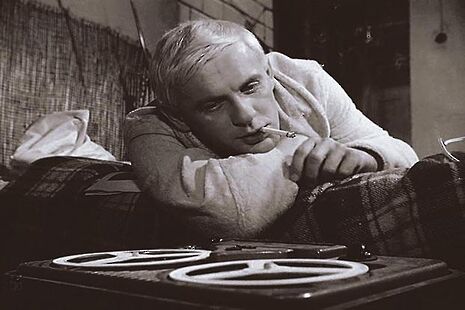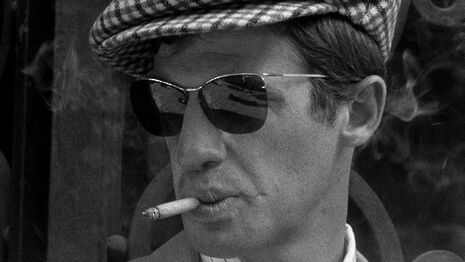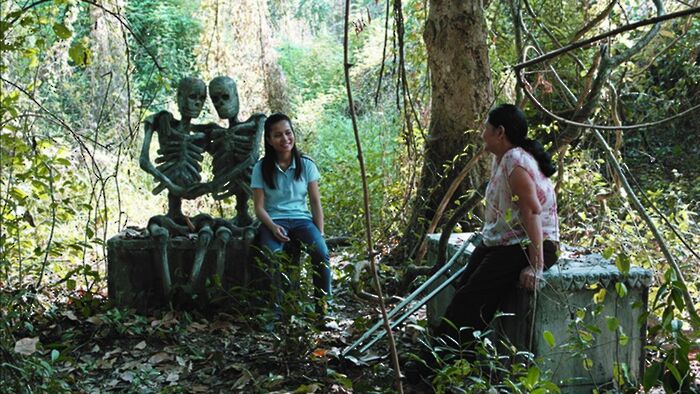Found in Translation: the underground jazz culture sweeping Eastern Europe
Inspired by her own wacky experiences, Madeleine Pulman-Jones reflects on the influence of jazz and existentialism in Eastern European cinema and the Polish Film School

We are standing in an apartment somewhere outside of the centre of St Petersburg. The room is in complete darkness but for a few atmospheric red and purple lights in the corners of the room. A tall young man who could have been anywhere between the ages of twelve and twenty-five bounces in wearing a blue suit and with bare feet. Following behind is a group of musicians in various kinds of blindfolds. Gradually, they find their way to their instruments. I am immediately drawn to the pianist who has taken the blindfold concept to extremes and is wearing a jute sack over his head.
“The Polish Film School was the result of young artists carving their own niche in the aftermath of the upheaval and unrest of WWII”
The young boy acts as a master of ceremonies of sorts, leading the band by tapping the instrumentalists when he wants them to stop or start improvising. The crowd is full of all kinds of people, from young artsy types to middle-aged academics. There is a bar in the next room and I am told by a friend that the owner of the ‘club’ sleeps on a makeshift mezzanine above the bar. Later, a man with a wild mop of brown curly hair passes around ‘canapés’, which consist of a piece of rye bread, a piece of lettuce, a pickled cucumber, and a slice of Russian cheese all skewered together on a toothpick.
This was not my first experience in the Eastern European jazz scene, but it was by far the wildest. I had previously been to a legendary jazz club in a medieval cellar in Krakow (still regarded by many as Europe’s jazz capital) and a trendy new spot in Moscow, but this was my first experience with ‘underground’ jazz. The event was secretly organised and only members of a VKontakte (‘In Contact’ – Russia’s Facebook equivalent) group could attend. Eastern Europe’s underground rave scene has been well-documented by trendy British media outlets such as Dazed and Confused and i-D, but their jazz scene is still a relatively well-kept secret. Unlike Slavic rave culture, which borrows its aesthetic largely from 90s rave and soviet punk, the Slavic jazz scene is still mostly inspired by the jazz craze that swept the USSR (particularly Poland) in the late fifties and sixties.
From 1958-1967, the period usually regarded as the French Nouvelle Vague (‘New Wave’), visionaries Jean-Luc Godard, Francois Truffaut, Jacques Rivette, Agnès Varda, and others, peopled French screens with restless youths in sunglasses and crisp suits who smoked infinite numbers of cigarettes, drank endless cups of coffee, and playfully batted about questions of existentialism on the streets of Paris. Almost every single one of these films features an iconic jazz soundtrack – most famously Miles Davis’s score for Louis Malle’s The Lift to the Scaffold (1958).

Meanwhile in Poland, from 1953 to 1963, the movement that came to be known as The Polish Film School was already well under way. Though primarily influenced by Italian Neorealism, films made by young Polish filmmakers such as Roman Polanski (later to be of Rosemary’s Baby and Chinatown fame), Andrzej Wajda, and Jerzy Kawalerowicz were similarly filled with unsatisfied post-war youths who also wore sunglasses and crisp suits, and who also smoked cigarettes and questioned existence – though perhaps they drank slightly more vodka than coffee. More sombre than the technicolour surrealism and absurdity of the Czech New Wave, The Polish Film School was the result of young artists carving their own niche in the aftermath of the upheaval and unrest of WWII, much like the underground scenes in Eastern Europe today in the years following the dissolution of the USSR.
The film that best embodies the spirit of that era is Andrzej Wajda’s Innocent Sorcerers (1960). Having received international acclaim with his war film, Ashes and Diamonds, Wajda decided to make a film about Polish youth culture. The witty and lyrical film follows jazz drummer and young medic Bazyli through a day in his life in Warsaw, hanging out with his fellow musicians, examining boxers before a big fight, playing a jazz competition with his band, and eventually picking up a witty and bright young woman named Pelagia at his favourite jazz club. The characters in this film are as frustrated with communist politics as they are with old-school Polish catholic morality, but a fog of general malaise and exhaustion hangs over the bohemian set. After playing what is clearly a great set at the competition, one of the members of Bazyli’s jazz band says, “that was absolutely terrible,” to which another replies, “so what – we’ll win anyway.” The film features a cameo by the young Roman Polanski pre-Hollywood superstardom which is worth looking out for.
Though not based around Poland’s jazz scene, another Polish film of this period which features an outstanding jazz score is Jerzy Kawalerowicz’ Night Train (1959). Made in the same year as Hitchcock’s train-based thriller, North by Northwest, the train’s passengers include a mysterious young blonde, a shifty man constantly wearing sunglasses, a young priest, and a flirtatious wife. The film is a stunning minimalist masterpiece in its own right with some incredibly poetic images, but the soundtrack which includes numbers by jazz singer Wanda Warska, and an instrumental score by the famous Polish jazz musician, Andrzej Trzaskowski, is a contender for the best jazz score of all time.
It has always been thought that the French New Wave was the epitome of ‘cinematic cool,’ but the wacky films of The Polish Film School could give it a pretty good run for its money
 News / Clare Hall spent over £500k opposing busway 24 December 2025
News / Clare Hall spent over £500k opposing busway 24 December 2025 Comment / The ‘class’ of Cambridge24 December 2025
Comment / The ‘class’ of Cambridge24 December 2025 News / Caius mourns its tree-mendous loss23 December 2025
News / Caius mourns its tree-mendous loss23 December 2025 Comment / Yes, I’m brown – but I have more important things to say22 December 2025
Comment / Yes, I’m brown – but I have more important things to say22 December 2025 News / Girton JCR publishes open letter expressing solidarity with Palestine25 December 2025
News / Girton JCR publishes open letter expressing solidarity with Palestine25 December 2025










